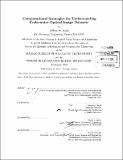| dc.contributor.advisor | Hanumant Singh and David E. Hardt. | en_US |
| dc.contributor.author | Kaeli, Jeffrey W | en_US |
| dc.contributor.other | Woods Hole Oceanographic Institution. | en_US |
| dc.date.accessioned | 2014-03-06T15:49:30Z | |
| dc.date.available | 2014-03-06T15:49:30Z | |
| dc.date.copyright | 2013 | en_US |
| dc.date.issued | 2013 | en_US |
| dc.identifier.uri | http://hdl.handle.net/1721.1/85539 | |
| dc.description | Thesis: Ph. D. in Mechanical and Oceanographic Engineering, Joint Program in Oceanography/Applied Ocean Science and Engineering (Massachusetts Institute of Technology, Department of Mechanical Engineering; and the Woods Hole Oceanographic Institution), 2013. | en_US |
| dc.description | Cataloged from PDF version of thesis. | en_US |
| dc.description | Includes bibliographical references (pages 117-135). | en_US |
| dc.description.abstract | A fundamental problem in autonomous underwater robotics is the high latency between the capture of image data and the time at which operators are able to gain a visual understanding of the survey environment. Typical missions can generate imagery at rates hundreds of times greater than highly compressed images can be transmitted acoustically, delaying that understanding until after the vehicle has been recovered and the data analyzed. While automated classification algorithms can lessen the burden on human annotators after a mission, most are too computationally expensive or lack the robustness to run in situ on a vehicle. Fast algorithms designed for mission-time performance could lessen the latency of understanding by producing low-bandwidth semantic maps of the survey area that can then be telemetered back to operators during a mission. This thesis presents a lightweight framework for processing imagery in real time aboard a robotic vehicle. We begin with a review of pre-processing techniques for correcting illumination and attenuation artifacts in underwater images, presenting our own approach based on multi-sensor fusion and a strong physical model. Next, we construct a novel image pyramid structure that can reduce the complexity necessary to compute features across multiple scales by an order of magnitude and recommend features which are fast to compute and invariant to underwater artifacts. Finally, we implement our framework on real underwater datasets and demonstrate how it can be used to select summary images for the purpose of creating low-bandwidth semantic maps capable of being transmitted acoustically. | en_US |
| dc.description.statementofresponsibility | by Jeffrey W. Kaeli. | en_US |
| dc.format.extent | 135 pages | en_US |
| dc.language.iso | eng | en_US |
| dc.publisher | Massachusetts Institute of Technology | en_US |
| dc.rights | M.I.T. theses are protected by copyright. They may be viewed from this source for any purpose, but reproduction or distribution in any format is prohibited without written permission. See provided URL for inquiries about permission. | en_US |
| dc.rights.uri | http://dspace.mit.edu/handle/1721.1/7582 | en_US |
| dc.subject | Joint Program in Oceanography/Applied Ocean Science and Engineering. | en_US |
| dc.subject | Mechanical Engineering. | en_US |
| dc.subject | Woods Hole Oceanographic Institution. | en_US |
| dc.subject.lcsh | Remote submersibles | en_US |
| dc.subject.lcsh | Image analysis Data processing | en_US |
| dc.title | Computational strategies for understanding underwater optical image datasets | en_US |
| dc.type | Thesis | en_US |
| dc.description.degree | Ph. D. in Mechanical and Oceanographic Engineering | en_US |
| dc.contributor.department | Joint Program in Oceanography/Applied Ocean Science and Engineering | en_US |
| dc.contributor.department | Woods Hole Oceanographic Institution | en_US |
| dc.contributor.department | Massachusetts Institute of Technology. Department of Mechanical Engineering | |
| dc.identifier.oclc | 871172709 | en_US |
